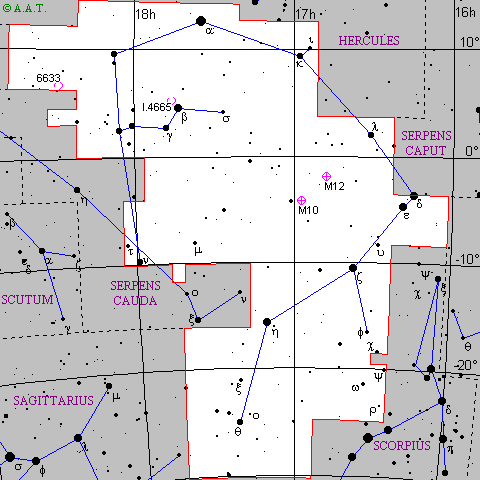 |
 |
| English name | Ophiuchus | ||||
|---|---|---|---|---|---|
| Stelle maggiori | alpha Ophiuchi | Ras Alhague | magn. 2,1 | RA: 17h 34m 56.06s | Dec: +12° 33' 36.7" |
| beta Ophiuchi | Cebalrai | magn. 2,8 | RA: 17h 43m 28.36s | Dec: +04° 34' 01.9" | |
| delta Ophiuchi | Yed Prior | magn. 3,0 | RA: 16h 14m 20.75s | Dec: -03° 41' 39.2" | |
| epsilon Ophiuchi | Yed Posterior | magn. 3,3 | RA: 16h 18m 19.27s | Dec: -04° 41' 33.0" | |
| zeta Ophiuchi | magn. 2,7 | RA: 16h 37m 09.55s | Dec: -10° 34' 01.6" | ||
| eta Ophiuchi | Sabik | magn. 2,6 | RA: 17h 10m 22.69s | Dec: -15° 43' 29.6" | |
| theta Ophiuchi | magn. 3,4 | RA: 17h 22m 00.58s | Dec: -24° 59' 58.2" | ||
| kappa Ophiuchi | magn. 3,4 | RA: 16h 57m 40.14s | Dec: +09° 22' 30.1" | ||
| ny Ophiuchi | magn. 3,5 | RA: 17h 59m 01.61s | Dec: -09° 46' 24.9" | ||
| Description | Big equatorial constellation, between Hercules and Scorpius. Even though Ophiuchus is not one of the twelve zodiacal constellations, the Sun transits through it during the month of December. Besides many double stars (eta, lambda, xi, omicron, tau Ophiuchi), rho Ophiuchi is particularly remarkable: it is a multiple star, constituted by two components of fifth and sixth magnitude, accompanied by two stars of eighth magnitude disposed in V shape. Every component is visible with small telescopes. Small telescopes also allow to see the star with the biggest own motion: it is the Barnard star, situated near Cebalrai, next to 66 Ophiuchi. This star is six light-years away from us and it is of magnitude 9,5: its movement is so rapid that in about 350 years it scours a degree of arc northwards. Some observations lead us to think that around the Barnard star there are at least two planets similar to Jupiter.
|
||||
| Mythology and history | The constellation represents Aesculapius, god of the medicine, son of Apollo. Aesculapius was educated by the centaur Chiron (represented in the constellation of Centaurus) and he became so skilled in medical arts that he succeeded not only in recovering the illnesses, but also in resuscitating the dead. Hyginus tells that one day Aesculapius killed a snake by striking it with his stick: then he saw another snake, which deposed a grass on the dead body, that immediately came back to life. In this way Aesculapius knew the secret of resurrection: therefore in the sky he is represented while he is holding a snake (that is the constellation of Serpens). The god of the hereafter, Hades, complained with Zeus that Aesculapius subtracted, against nature, the dead souls from his kingdom: Zeus then killed Aesculapius with his thunderbolt and he indemnified him by giving him a place among the stars. |
||||
 Back to constellations page.
Back to constellations page.